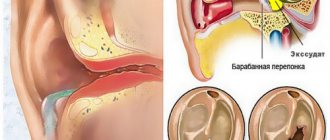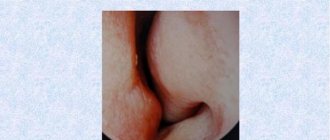Rhinopharyngitis is usually called an inflammatory process in the nasopharynx of an acute or chronic course. Most often, the pathology occurs in children of kindergarten age and develops due to insufficient treatment of a common runny nose.
Nasal congestion and the discharge of clear mucus from the nasal passages may indicate the presence of an inflammatory process of bacterial or viral etiology. Accordingly, appropriate therapy is necessary to avoid complications.
Reasons for development
The development of acute nasopharyngitis does not occur simultaneously, it is a gradual process. Usually it all starts with nasal congestion and, without appropriate treatment, ends with inflammation of the larynx with quite severe pain. In the vast majority of cases, the process has a viral etiology and occurs as a result of the penetration of an adenovirus, influenza or rhinovirus into the body.
Less commonly, the process is of an allergic nature or is a consequence of the pathological influence of pathogens. Viral pathology develops immediately after the strain enters the body. Bacteria, on the contrary, can be present in the body for a long time without showing themselves in any way, and when immunity decreases for one reason or another, they begin to have a detrimental effect.
The development of pathology can be provoked by:
- severe hypothermia or, conversely, overheating (especially in the sun);
- untreated colds;
- decreased immune defense;
- leading an unhealthy lifestyle, especially alcohol abuse or smoking;
- contact with an infected person;
- visiting crowded places, especially during epidemics;
- exacerbation of chronic pathologies.
Pathology tends to become chronic. And in this case, the treatment will be very long and often complex.
Chronic nasopharyngitis is provoked by:
- enlarged adenoids and polypous process in the nasal cavity;
- curvature of the nasal septum;
- congenital disorders in the structure of the respiratory apparatus and especially the nose;
- candidiasis of the oral cavity and nasopharynx;
- drinking very cold drinks (even during hot periods);
- taking medications that weaken the body’s immune defense;
- constant exposure to stressful situations.
The acute form of the pathology, as a rule, begins a day or two after infection. The further development of symptoms depends on the form of nasopharyngitis, of which there are three in total in the acute phase.
Causes of acute tracheitis in children and adults
Note! Common causes of tracheitis for children and adults are:
- Severe hypothermia of the body . In this case, immunity begins to decline, which contributes to the development of pathogenic and opportunistic microorganisms that are present in the body. The younger the patient, the more likely it is that pathogenic microflora will begin to provoke the development of diseases.
- Prolonged fasting and poor diet . In this case, the body does not receive enough important microelements, which should help improve immunity.
- Allergy . Mucous membranes sensitive to allergens begin to become inflamed upon contact with them. Allergens can be various irritants - from food to chemicals. At the same time, a predisposition to allergies can be congenital, or it can develop throughout life due to constant contact with irritants (for example, living or working in polluted air).
- The impact of foreign bodies entering the tracheal mucosa . Such objects cause local inflammation as a result of the body's attempts to remove the foreign object.
- Polluted air , in which there is an increased amount of dust, chemicals, smoke or soot.
- Any infectious chronic diseases of internal organs . In such cases, there is a risk that pathological microflora may spread to the respiratory tract.
Typically “adult” causes of acute tracheitis are smoking and alcohol abuse .
These are not only strong irritants that affect the mucous membranes, but also causes a weakening of the immune system.
Carefully! In childhood, tobacco smoke can also cause acute tracheitis due to passive smoking (for example, if parents smoke in the apartment).
Acute nasopharyngitis – code according to ICD10
Acute pharyngitis (J02)
Included: acute sore throat
Excluded:
abscess:
- peritonsillar (J36)
- pharyngeal (J39.1)
- retropharyngeal (J39.0)
- acute laryngopharyngitis (J06.0)
- chronic pharyngitis (J31.2)
J02.0
- Streptococcal pharyngitis
- Streptococcal sore throat
Excludes: scarlet fever (A38)
J02.8
Acute pharyngitis caused by other specified pathogens
If necessary, identify the infectious agent, use an additional code (B95-B98)
Excluded: pharyngitis caused (by):
- enteroviral vesicular (B08.5)
- caused by herpes simplex virus (B00.2)
- infectious mononucleosis (B27.-)
- influenza virus:
- identified (J09, J10.1)
- unidentified (J11.1)
last modified: October 2005
J02.9
Acute pharyngitis, unspecified
Pharyngitis (acute):
- NOS
- gangrenous
- infectious NOS
- purulent
- ulcerative
Sore throat (acute) NOS
Kinds
Catarrhal form
Characterized by the appearance of redness and swelling of the mucous membrane. An accumulation of white or clear mucus appears in the nasal cavity. If the temperature rises, it is only to subfebrile levels.
Mostly, patients have to deal with dry mucous membranes and a sore throat, pain that worsens when swallowing, a runny nose, nasal congestion and an unproductive cough.
Purulent form
The main characteristic of this type of acute pharyngitis is bacterial etiology. Upon visual examination, the presence of purulent discharge in the nasal cavity is observed. The mucous membrane of the nasopharynx is swollen and hyperemic, individual lymphatic follicles on the back wall of the throat are enlarged.
There is an increase in body temperature to febrile values. The cervical and sublingual lymph nodes enlarge and respond with pain upon palpation. Nasal discharge becomes green or yellow in color. The patient's general condition worsens, and intoxication is observed. A person begins to feel aches in joint and muscle tissue, loses appetite, experiences weakness and headache.
The purulent form of acute pharyngitis tends to develop into a sore throat, frontal sinusitis, sinusitis and other complications. Without proper treatment, the inflammatory process spreads to the ear canals and can lead to otitis media of varying severity.
Allergic form
Allergic reactions
It is important to understand that this form in itself is not a disease, but rather a condition provoked by exposure to allergens on the human body. Most often it occurs due to air or food factors. The process does not occur in all patients, but only in the presence of individual sensitivity to a particular substance.
Symptoms appear immediately after contact with the allergen and disappear on their own after its isolation. This form does not require specific treatment; it will be enough to eliminate the initiating factor. However, in severe cases, it is necessary to take antihistamines to relieve the patient of negative symptoms.
The acute form of the disease can become chronic under the influence of certain factors. Reduced immunity, the presence of carious teeth in the oral cavity and, as a result, a constant source of infection, untreated infectious lesions - all this can lead to a more serious type of pathology. This form is, in fact, an endless alternation of exacerbation and remission over many years.
Chronic nasopharyngitis is divided into:
Catarrhal
WITH
periodically occurring runny nose, a feeling of dry throat mucosa, constant swelling and congestion of the nasal passages. Upon visual examination, the mucous membrane has moderate redness, mucus flows down the back wall of the larynx, and single enlarged follicles are observed.
Atrophic
IN
Occurs as a consequence of exposure to aggressive substances. It can be caused by: active drinking of strong alcoholic beverages, smoking, as well as inhalation of chemical compounds in hazardous industries. In old age, the atrophic form can occur due to physiological age-related changes.
Symptomatic manifestations include:
- feeling of dryness on the mucous membranes of the nose and throat,
- swallowing dysfunction,
- the appearance of a sensation of a foreign body in the throat.
Treatment
Effective treatment of tracheitis involves long-term drug therapy, which is usually carried out at home (only in particularly difficult cases can the patient be prescribed treatment in a hospital setting). Treatment also includes drinking plenty of fluids, bed rest, and restrictions on activity.
By medication
For tracheitis, the patient is usually prescribed several groups of medications. Among them:
- Mucolytic agents. Provides easier expectoration.
- General strengthening drugs. Often these are interferon-based agents. Accelerate the recovery of the body.
- Inhalations. Alkaline solutions are often prescribed for them. These remedies allow you to quickly restore the throat mucosa.
- If a person has coughing attacks that are painful for him, take antitussive drugs. Taking such drugs, however, is possible only if there are no mucolytics in the patient’s treatment regimen.
Also, in case of a complicated form of tracheitis, accompanied by the release of purulent sputum, chest pain, as well as a significant increase in temperature, the patient may be prescribed antibiotics. However, their use in the treatment regimen is not mandatory.
Folk remedies
Traditional recipes also help cope with the symptoms of tracheitis, however, unlike medications, they cannot eliminate the cause of the disease. That is why it is better to use them as an adjuvant therapy before consulting a doctor or together with antibiotics or symptomatic drugs. The most effective means in the fight against tracheitis are:
- Blackberry infusion. To prepare it, you will need 2 tablespoons of chopped blackberry leaves and a glass of boiling water. You need to steam the leaves in boiling water for 15 minutes, then drink this infusion instead of tea. This remedy should be used 4 times a day.
- Mustard baths. You will need to dilute mustard powder in a bowl of hot water and steam your feet in it. After such a bath, you will need to take fresh, preferably woolen socks, pour mustard into them, put them on your feet and go to bed. Please note that this remedy can only be used if the person does not have a fever.
- Decoction of pine buds. You will need to take half a liter of milk, pour it into a small saucepan, put it on the fire and bring it to a boil. Then you will need to add a tablespoon of pine buds to it. The mixture should then be removed from the heat, cooled, strained well and given to the patient to drink in small portions several times a day.
- Compresses. This method can only be used if the patient does not have a high fever. You will need to proceed as follows: boil the potatoes, cool slightly (otherwise such a compress can cause a burn), crush them and wrap them in gauze. This gauze should be placed on the patient's chest for several hours. This remedy will facilitate the separation of sputum and speed up recovery.
Remember that natural medicines, for example, herbal infusions, can cause allergies in a person. To avoid its occurrence during treatment, be sure to first test a small amount of such drugs to make sure that they will be absolutely safe for your patient.
Symptoms
Depending on the etiology of the inflammatory process and the form of the pathology, symptomatic manifestations can vary quite significantly. Only an experienced specialist can correctly diagnose and determine the necessary treatment regimen.
Infectious inflammation is characterized by:
- a feeling of dryness of the mucous membrane of the nasal passages and a rather strong burning sensation;
- the appearance of mucous discharge from the nose;
- the appearance of nasality and difficulty breathing;
- sneezing and itching;
- sore throat;
- dry cough;
- feeling of a lump in the throat, pain when swallowing;
- slight increase in body temperature;
- congestion in the ears when the infection passes into the ear canals;
- headache.
The course of acute nasopharyngitis in childhood varies significantly and may include a number of additional manifestations. Often, young patients develop flatulence and problems with stool, high fever, sleep disturbances and irritability. In very infants, the effect of regurgitation may even occur.
Acute symptoms in adults and children
The symptoms of acute tracheitis in adults and children are not very different, but have their own characteristics.
Important! In adult patients, the first obvious symptom is a dry, non-productive cough that gets worse at night and in the early morning. Pain appears in the throat and behind the sternum.
After a few days, when coughing, sputum begins to separate , and its color and consistency depend on the stage and etiology of the disease.
children also exhibit others:
- increased temperature (sometimes above 38 degrees);
- breathing problems;
- shrunken, hoarse voice.
An increase in temperature is usually not typical for adult patients, and if it does rise, it is almost always no more than 37 degrees.
Diagnosis of nasopharyngitis
A detailed diagnosis is made on the basis of the collected epidemiological history, subjective complaints of the patient, data obtained from face-to-face and instrumental examinations and laboratory tests. If necessary, bacteriological culture and endoscopic examination of the pharynx are also performed.
Most often, patients complain about:
- unpleasant sensations of burning and dryness in the nasopharynx;
- viscous mucus in the sinuses;
- the presence of minor pain in the throat;
- tickling and non-productive cough;
- congestion of the ear canals and hearing loss;
- painful sensations in the back of the head;
- high temperature (more often typical for children).
During the examination, the submandibular nodes (lymphatic) are palpated, which respond with moderate pain. During endoscopic rhinoscopy, a specialist may note redness of the mucous membrane and the presence of a viscous secretion. The allergic form is characterized by pallor and cyanosis of the mucous membrane.
Additional examinations may also be performed according to indications. To determine the nature of the bacteriological process, smears from the back of the throat are analyzed. Streptococcal antigen is determined using the express method.
How to treat
Of course, only a specialist can prescribe a specific therapy. Its nature depends on the form of the pathology and the nature of the course of the pathology. However, there are general provisions that can be followed to alleviate the condition of acute and chronic pharyngitis.
In adults
Allergic rhinopharyngitis is treated with:
- Antihistamines – Duration of treatment is seven days. Adult patients and adolescents can take tablet forms, for example Suprastin. It is better to give children Fenistil or Zyrtec drops.
Zyrtec - Isolation of the allergen - without this point, therapy will not work, because immediately after stopping taking antihistamines, all symptoms will return. If it is not possible to find out the type of allergen at home, then you can undergo a special test.
- Sprays based on hormonal components. They allow you to reduce the degree of swelling and eliminate the inflammatory process. The course of their use ranges from two to four weeks. The drug is administered into the nasal cavity once a day. An example of such a drug is Nasonex or its analogues.
To treat acute rhinopharyngitis it is necessary:
- Take antipyretics. An increase in body temperature above 38-39 degrees can lead to convulsions. This should not be allowed. You can take medications based on paracetamol and ibuprofen.
- Use antiviral medications. Anaferon, Kagocel, Viferon and Arbidol are suitable for the treatment of viral pathology.
- Take antimicrobial agents. The bacterial type of disease must be treated with antibiotics, such as Azithromycin or Amoxicillin.
- Rinse the nasal passages with saline or sea water-based products. This procedure is carried out up to six times a day.
- Use vasoconstrictor drops, for example, Otrivin, Nazivin or Vibrocil. The duration of therapy should not exceed five to seven days. In the future, addiction may develop.
- Rinse the nasopharyngeal cavity with antiseptic solutions. You can use salt rinses, herbal decoctions or furatsilin. The procedure must be repeated up to eight times a day.
- Instill drops with a therapeutic effect into the nasal passages, for example, Pinosol based on oil extracts of herbs or Protargol, containing silver ions.
- Use antitussives. The type of drug depends on the form of cough. So Sinekod will be useful for the non-productive form, and Mucaltin will help remove phlegm.
The use of medications is not enough for a quick and complete recovery. During the active course of the disease, it is recommended to slightly reduce the calorie content of the diet and remove hot, cold, spicy and very salty foods from it.
Fluid intake increases to two liters per day. It is better to give preference to a slightly warm drink. Dry air can only aggravate the problem, so you should monitor the humidity in the room and ventilate the room up to three times a day. In the first three days, you must observe bed rest.
In children
Therapy for acute nasopharyngitis is somewhat different, this is primarily due to the patient’s age and imperfect immunity. An increasing number of pediatricians prescribe antibiotic therapy to young patients even without establishing the etiology of the pathology.
Recent studies have proven that inflammatory processes in the pharynx and nasal cavity are often caused by viral pathogens. And accordingly, antibiotics will be ineffective at best, and at worst they will reduce the immunological status of the child. Modern pediatrics offers to treat pathology with topical agents.
To treat rhinopharyngitis in children it is necessary:
- switch to a more gentle diet - low-fat warm broths and liquid porridges;
- rinse the throat with antiseptic solutions up to four times a day;
- irrigate the surface of the throat with antibacterial sprays up to three times a day;
- dissolve tablets and lozenges with analgesic, emollient and antiseptic properties.
Etiology, pathogenesis
An acute inflammatory process in the trachea and larynx can be caused by viruses, the causative agent of infectious diseases (influenza, rubella, measles, chickenpox), pathological microorganisms (staphylococcus, pneumococcus, Koch's bacillus). Most often, the disease affects children, and in adults it occurs in a milder form due to its anatomical structure.
Acute laryngitis according to ICD 10 has the following forms
- catarrhal;
- with severe swelling;
- phlegmonous form (may have an abscess or infiltrative course).
Each form has characteristic subjective complaints and symptoms, on the basis of which a preliminary diagnosis is made. The leading symptom of acute laryngitis and tracheitis is considered to be a sharply beginning barking cough against the background of normal general health. Difficulty breathing and increasing symptoms of intoxication appear a little later.
The phlegmonous form is characterized by severe pain in the throat, up to the inability to swallow liquid.
In most cases, laryngitis in ICD 10 is recorded in children who, when the temperature rises to 39-40 degrees, have respiratory failure in the form of false croup or laryngeal stenosis. In such cases, the child must be urgently hospitalized.








